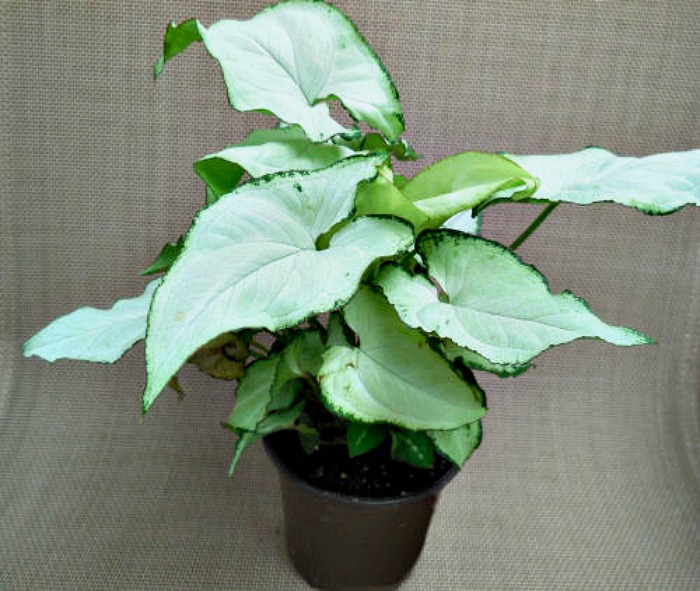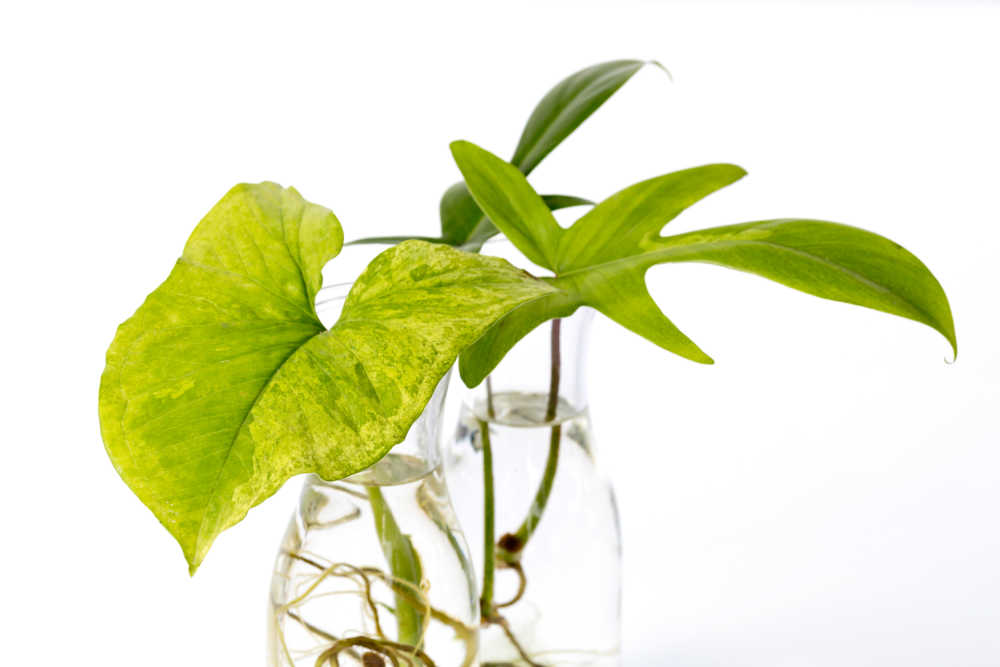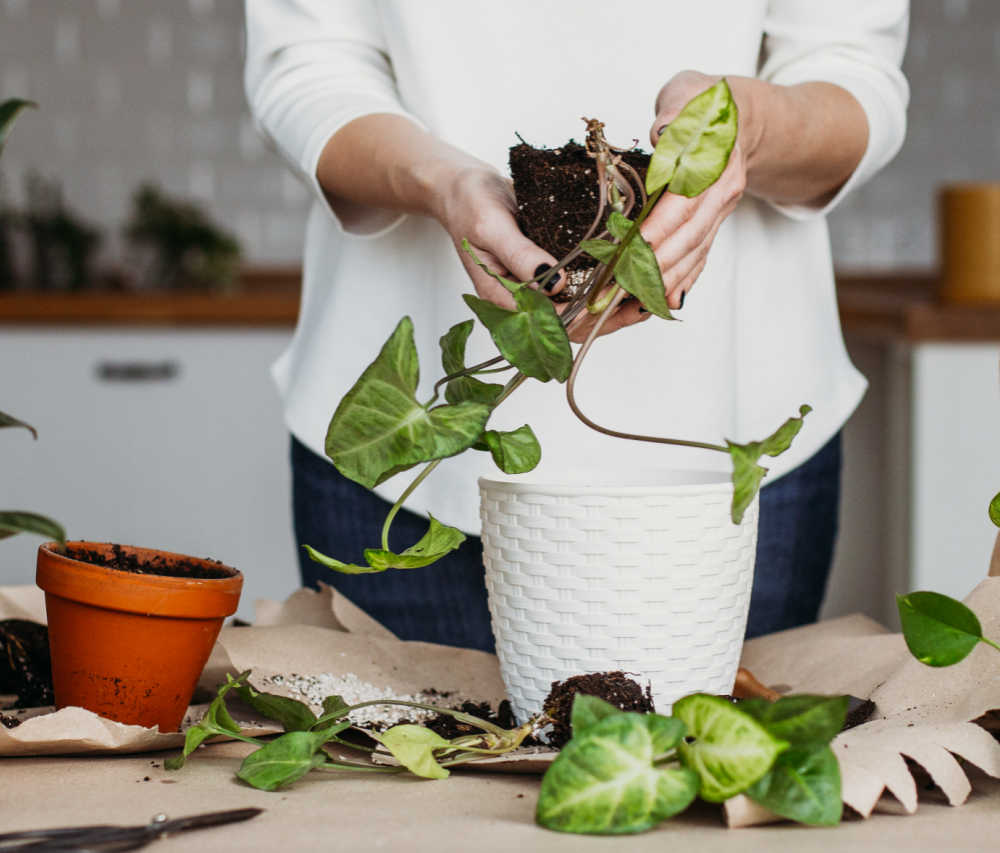Arrowhead plant care is easy even for beginners. The plant doesn’t mind lower light conditions and has minimal care tips to keep it growing in tip top shape.
As a houseplant, it is typically grown for its attractive foliage which changes shape as the leaves get larger. Syngonium plants have been popular indoor plants in many areas of the world for years. The botanical name is syngonium podophyllum.
This plant is commonly known as the arrowhead vine. One an easily see why when looking at the leaves. Other common names are arrowhead philodendron, goosefoot, nephthytis, African evergreen, and American evergreen.
The plant is native to the tropical rain forests in Central and South America. It is a fast growing plant for a beginner and is often used as a table top plant.

Share this post about syngonium plant care tips on Twitter:
Syngonium podophyllum has leaves shaped like arrowheads. It doesn't mind low light and is an easy care houseplant. Find out how to grow arrowhead plants on The Gardening Cook. Click To TweetArrowhead plant care tips
Syngonium Podophyllum plants are quite easy to grow, which makes them ideal house plants for beginners. Just follow these syngonium plant care tips.
Arrowhead plant sunlight light requirements
A spot with bright indirect light (not direct sunlight) is best. Sunlight can scorch the plant easily. Rotate the plant to insure even growth.
Since the plant only needs low light, it can be used in parts of the home where sunlight is not abundant.
The variegated varieties can take a bit more sun, while the solid green types like shady conditions.
When to water arrowhead plant
Water every 2-5 days during the summer to keep the soil evenly moist but reduce watering in the winter months hen the plant is more dormant.

They will benefit from misting to keep the humidity high. You can also place the pot on a tray of pebbles in water to increase humidity.
When the top soil becomes dry to the to the touch slightly, but do not let the soil dry out.
Arrowhead plant soil and temperature needs
Exotic allusion arrowhead plant enjoys a potting soil that drains well.
Keep the plant in the 60 – 85 ° F range if possible. The plant loves warmth! These temperatures need to be maintained year round. Temperatures lower than 50° F can kill your plant.
How to fertilize syngonium vines
Feed this plant regularly with a liquid fertilizer during the spring and summer months. No feeding is necessary in the winter because the plant is dormant and the growth slows down.
Arrowhead plant foliage
The leaves of syngonium are spade shaped or arrowhead shaped, which gives it one of its common names.

The leaves change shape as the plant grows. They start out with an arrowhead shape and then gradually change into foliage with 3 to 5 finger-like sections.
Generally the leaves are green in color but there are also many varieties of syngonium.
Arrowhead plant flower
Arrowhead plants are often found growing in water in their native environments. The flowers are white and have three whorls and sit above the water surface.

The flower has three white petals as well as a small cluster of yellow stamens which hold pollen.
Arrowhead plants don’t normally flower indoors, particularly if you prune the plant often to keep it bushy.
Toxicity of arrowhead plants
Many household plants can be toxic to pets and humans.
Arrowhead plant is poisonous to pets, so you should keep your plant well away from cats and dogs. The toxicity level is mild to moderate but can cause your pet to become unwell if they ingest them.

Signs of toxicity in pets are irritation in the mouth area, pain and swelling of mouth, tongue and lips, excessive drooling, vomiting and difficulty swallowing.
The sap of arrowhead plants can also be a problem for people, too, so it is a good idea to protect children from them.
Arrowhead plant problems
Be on the lookout for yellowing leaves. This could indicate both overwatering or underwatering. Brown leaf tips indicate a lack of humidity. Mist often to correct this.
Slow growth is normal in the winter months when the plant is dormant. Lack of growth in other months means that fertilizer is called for, or that more light is needed.
The products shown below are affiliate links. I earn a small commission, at no extra cost to you if you purchase through an affiliate link.

Arrowhead plant varieties
Syngonium varieties come in many color types as well as a solid green syngonium variety. Here are a few to look for when plant shopping:
- Syngonium Exotic allusion – light green leaves are evenly mottled with creamy white shade of green
- Pink splash – delightful mix of pink splashes and green colors to the leaves
- Mini pixie – tiny syngonium that grows in clumps
- Syngonium variegatum – has splotches of green on a pale green background
- Bold allusion – pale green leaves with pink veins. It would look lovely as a focal plant on a side table.
- Emerald gem – leaves are an emerald green shade with deep creams veins. It is compact in size.
- Albolineatum syngonium – pale green leaves in a distinct arrow shape. As it grows, it develops a deeper color. Quick growing variety.
- Holly syngonium – pale white leaves in an arrowhead shape with small splotches of green.
Propagating arrowhead plant
Syngonium propagation is simple to do. If your stem has some aerial roots along it, cut this section and root syngonium plant in water for greater success.

Arrowhead plants can be propagated from cuttings that will root in both water and soil.
To propagate arrowhead plant, cut a 6-12″ section of the stem just below a leaf node. Plant the cutting in moist potting mix.
Rooting arrowhead plant in water is very easy. You just put the stem directly in water to root.
New roots will appear within 1-2 weeks and new leaves will start growing after about a month.
Syngonium plants can also be propagated by air layering, but this is more difficult.
Growing tips for syngonium vines
The plant grows fairly quickly so repotting arrowhead plant will be necessary. Re-potting in larger pots will let your plant will increase in size quickly. For a large plant, repot every year or two.

Use trailing arrowhead plants as trailing plants in the hanging baskets, or train them to climb up poles or moss sticks. They are a wonderful choice for a sunroom, where the heat, light and humidity fit their needs perfectly.
Prune syngonium plants regularly. Doing this will encourage new growth and make the plant more bushy.
Pinching the growing tips also gives stems that can be rooted into new plants.
Syngonium is thought by those who believe in feng shui to be a lucky plant and it is thought to attract good luck to the home.
Pin this post for taking care of an arrowhead plant
Would you like a reminder of this post for syngonium care tips?? Just pin this image to one of your gardening boards on Pinterest so that you can easily find it later.
If you enjoyed this post, you can also watch our video for growing other indoor plants on YouTube.

Arrowhead Plant Care Tips

Syngonium plant is also known as an arrowhead plant due to the shape of its leaves. It is an easy plant to grow, Just follow these care tips
Materials
- Syngonium plant
Tools
- Watering Can
- All purpose plant fertilizer
Instructions
- Place arrowhead plant in a bright spot with indirect sunlight. (keep out of direct sun)
- Water when the soil starts to become dry.
- Water less frequently in the winter when the plant is dormant.
- Repot into a larger pot once every 1-2 years.
- Use well draining potting soil.
- Keep the plant in the 60 - 85 ° F range if possible. Do not let the temps fall below 50 degrees F.
- Fertilize monthly with an all purpose plant food. Do not fertilize in the winter months.
- Prune often to make the plant more bushy.
- Propagate by stem cuttings in soil or water. Can also be air layered.